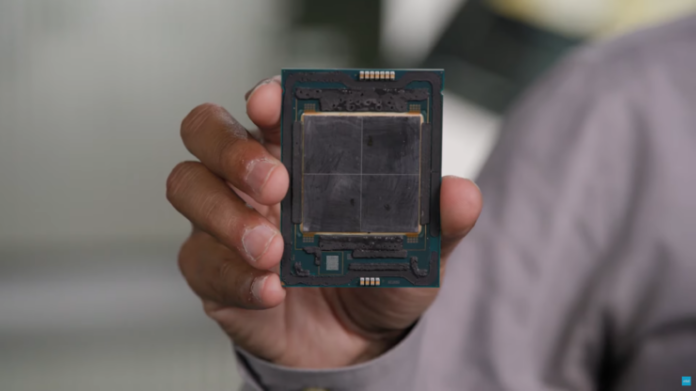
Intel's upcoming Sapphire Rapids-SP Xeon Platinum CPUs have been tested in a quad-socket configuration, offering up to 224 cores & 448 threads.
Intel's Sapphire Rapids-SP Xeon Platinum CPUs Tested In Quad-Socket Server, Offer Up To 224 Cores & 448 Threads
The CPUs that were tested within the quad-socket configuration include the 56 Core Xeon Platinum 8480+ and the 24 Core Xeon Platinum 8450H. The Xeon Platinum 8480+ is one of the top SKUs that offers 56 cores, 112 threads, 105 MB of L3 cache, and 112 MB of L2 cache while the clock speeds for the chip were configured at 1.9 GHz base and 3.7 GHz boost. The Xeon Platinum 8450H, on the other hand, features 28 cores, 56 threads, 75 MB of L3 cache, 56 MB of L2 cache, and clock speeds rated at 2.0 GHz base and 3.5 GHz boost.
Both chips tested are engineering samples and were tested on the Supermicro X13QEH+ SMC X13 platform which features support for DDR5 memory. The Intel Sapphire Rapids-SP Xeon CPU lineup comes with Golden Cove cores and we recently detailed the specifications for the entire family over here. This is a quad-socket platform that can support up to four Xeon CPUs so we are getting up to 224 cores and 448 threads. These are more cores and threads than AMD's EPYC 2P configurations which only allow for up to 128 cores and 256 threads.
In terms of performance, these CPUs were first tested in the Arithmetic tests within SiSoftware SANDRA. The Xeon Platinum 8480+ scored 2987.54 GOPs while the Xeon Platinum 8450H scored 2754.32 GOPs. In the Multimedia tests, the Xeon Platinum 8480+ scored 18,838.67 Mpix/s while Xeon Platinum 8450H's quad-socket config scored 14,404.89 Mpix/s. Compared to the AMD EPYC parts, the Arithmetic performance was similar to AMD's EPYC 7742 64-core CPU which is based on the older Rome design while the 8450H lost to the same configuration. In multi-media tests, both Xeon chips took a huge beating by AMD's EPYC lineup.
Intel Xeon Platinum SiSoftware SANDRA Arithmetic Benchmarks:

Intel Xeon Platinum SiSoftware SANDRA Multimedia Benchmarks:

Now it is possible that these non-server workloads and the fact that this is a Windows 64-bit OS, cannot take full advantage of Intel's Sapphire Rapids-SP Xeon chips at the moment but at the same time, AMD's EPYC chips seem to be doing just fine. We did mention that these chips are still early samples so they may not be running at the advertised clock speeds. Intel has claimed that their Xeon Sapphire Rapids-SP chips are faster than Zen 3-based 3D V-Cache EPYC Milan-X CPUs but those are when comparing the HBM parts and not the non-HBM chips like the ones tested here.
SiSoftware SANDRA Arithmetic Benchmarks (Intel Xeon vs AMD EPYC)
It looks like AMD will still hold the upper hand in the number of cores & threads offered per CPU with their Genoa chips pushing for up to 96 cores whereas Intel Xeon chips would max out at 60 cores if they don't plan on making SKUs with a higher number of tiles. Intel will have a wider and more expandable platform that can support up to 8 CPUs at once so unless Genoa offers more than 2P (dual-socket) configurations, Intel will have the lead in the most number of cores per rack with an 8S rack packing up to 480 cores and 960 threads. The Xeon Sapphire Rapids-SP family is expected to begin volume ramp in late 2022 while AMD will be shipping its Genoa EPYC 9000 line in Q4 2022.
AMD EPYC Genoa vs Intel Xeon Sapphire Rapids-SP Server CPU Platforms
| Server Family | AMD EPYC Genoa | Intel Xeon Sapphire Rapids-SP |
|---|---|---|
| Process Node | 5nm | Intel 7 |
| CPU Architecture | Zen 4 | Golden Cove |
| Cores | 96 | 60 |
| Threads | 192 | 120 |
| L3 Cache | 384 MB | 105 MB |
| Memory Support | DDR5-5200 | DDR5-4800 |
| Memory Capacity | 12 TB | 8 TB |
| Memory Channels | 12-Channel | 8-Channel |
| TDP Range (PL1) | 320W | 350W |
| TDP Range (Max) | 700W | 764W |
| Socket Support | LGA 6096 'SP5' | LGA 4677 'Socket P' |
| Launch | 2H 2022 | 2H 2022 |
The post Intel Sapphire Rapids-SP Xeon Platinum 8480+ 56 Core & Platinum 8450H 28 Core CPUs Tested In Quad-Socket Sever by Hassan Mujtaba appeared first on Wccftech.
WccftechContinue reading/original-link]






